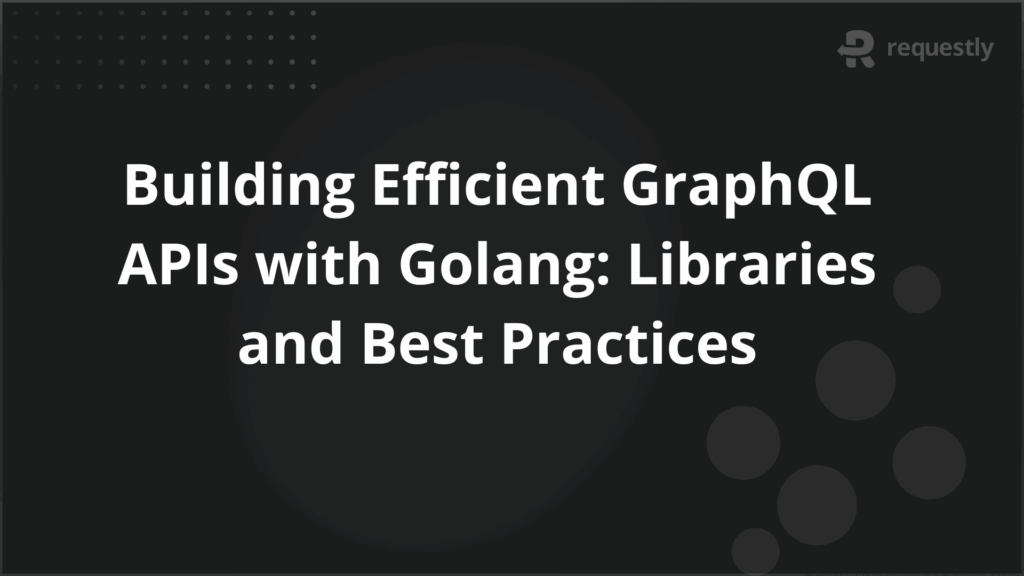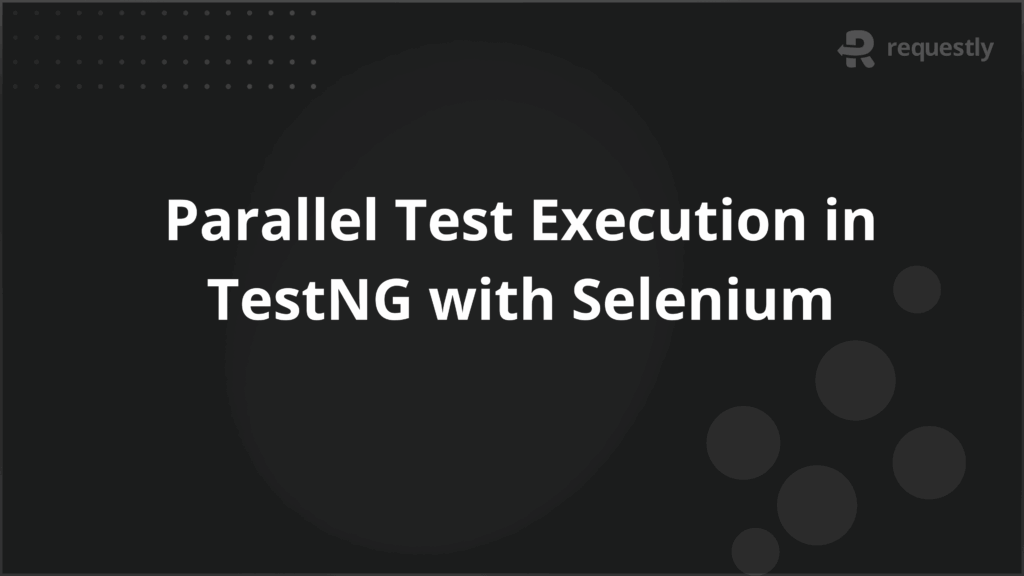Building Efficient GraphQL APIs with Golang: Libraries and Best Practices


GraphQL has transformed the way APIs are designed and consumed, offering a flexible and efficient alternative to traditional REST APIs. When combined with Golang, known for its performance and simplicity, developers can build powerful GraphQL APIs that are both scalable and maintainable.
This article explores the essentials of GraphQL, highlights the benefits of using it with Golang, and guides you through creating your own GraphQL API using popular Golang libraries
Understanding GraphQL Basics
GraphQL is a query language and runtime for APIs that enables clients to request exactly the data they need, no more and no less. Unlike REST, where endpoints return fixed data structures, GraphQL allows clients to specify the shape and size of the response, making data retrieval more efficient and precise.
At its core, GraphQL operates on a single endpoint that accepts queries describing the desired data, which the server then resolves and returns in a structured format.
The key components of GraphQL include:
- Schemas: Define the structure of the API, outlining available data types and operations.
- Types: Specify the kind of data that can be queried or mutated.
- Queries: Used to fetch data from the server.
- Mutations: Used to modify or update data.
- Subscriptions: Enable real-time updates by notifying clients of changes.
This flexible approach reduces over-fetching and under-fetching of data, streamlines API communication, and improves overall performance.
Advantages of Using GraphQL with Golang
Using GraphQL with Golang brings several notable advantages that enhance API development and performance:
- Efficient Data Fetching: GraphQL allows clients to request exactly the data they need, avoiding over-fetching or under-fetching common in REST APIs. This leads to faster and more efficient API responses, especially beneficial in high-performance Golang applications.
- Strongly Typed Schema: GraphQL leverages a clear and strongly typed schema, which is a good fit for Golang’s emphasis on type safety. This enhances code robustness by enabling compile-time validation and reducing runtime errors.
- Single Endpoint Simplicity: Unlike REST APIs with multiple endpoints, GraphQL exposes a single endpoint for all data queries and mutations, simplifying API management and reducing complexity for developers.
- Flexibility in Schema Design: The declarative syntax of GraphQL makes schema design and evolution easier. Developers can iterate and extend APIs without breaking existing clients, supporting agile development in Golang projects.
- Introspection and Developer Experience: GraphQL’s introspection capabilities allow clients to dynamically discover the schema, making it easier to explore APIs and integrate them smoothly, boosting developer productivity.
- Reduced Network Load: By fetching precisely the needed data in one request, GraphQL reduces the amount of data transferred over the network, which is particularly valuable in microservices and distributed Golang systems.
These combined advantages make GraphQL and Golang a powerful pairing for building scalable, flexible, and efficient APIs that meet modern application demands.
Popular Golang Libraries for GraphQL
When building GraphQL APIs in Golang, several libraries stand out for their features, community support, and ease of use:
gqlgen
This is the most popular and widely adopted GraphQL library in the Golang ecosystem. It uses a schema-first approach where developers define the GraphQL schema, and gqlgen generates strongly typed code to implement resolvers. It emphasizes type safety, speed, and productivity through code generation, making development faster and less error-prone.
graphql-go
One of the earliest GraphQL libraries for Go, graphql-go follows a code-first approach. It supports queries, mutations, and subscriptions, and offers a more manual way to build GraphQL APIs. It provides flexibility for developers who prefer defining schema and resolvers directly in Go code.
Ent with gqlgen
Ent is a powerful entity framework for Go that can be combined with gqlgen to simplify database schema definitions and seamless integration with GraphQL APIs. It helps solve common problems like the N+1 query issue with built-in optimizations.
graphjin
A lesser-known option that automates the process of building GraphQL APIs from a Postgres database by generating queries automatically. It is useful for rapid prototyping and projects heavily reliant on relational databases.
thunder
An experimental, opinionated GraphQL server library for Go by SamsaraHQ, designed to simplify GraphQL server development with conventions and built-in best practices.
Among these, gqlgen combined with Ent has become a favorite choice due to its balance of automation, type safety, and performance suited for production-grade applications.
Choosing the right library depends on your project’s needs, such as schema design preferences, database integration, and level of customization required.
Step-by-Step: Creating a GraphQL API in Golang
Creating a GraphQL API in Golang can be straightforward by following key steps, especially when leveraging a library like gqlgen.
Step 1: Set Up Your Golang Project
Initialize a new Golang module and install gqlgen. Use the command:
go mod init your_project_name
go get github.com/99designs/gqlgen
Step 2: Define Your GraphQL Schema
Create a schema.graphql file where you define your data types, queries, and mutations. For example:
type Query {
hello: String!
}
Step 3: Generate Boilerplate Code
Use gqlgen to generate code based on the schema:
gqlgen generate
This creates the necessary resolver interfaces and models.
Step 4: Implement Resolvers
Write the logic for each query and mutation in the generated resolver files. For example, return a greeting string for the hello query.
Step 5: Set Up the Server
Create an HTTP server using a router like net/http or gin-gonic and register the gqlgen GraphQL handler:
http.Handle("/query", handler.GraphQL(NewExecutableSchema(Config{Resolvers: &Resolver{}})))
http.ListenAndServe(":8080", nil)
Step 6: Test Your API
Use tools like GraphiQL or Postman to run GraphQL queries against your server. You can also integrate automated tests.
Step 7: Expand and Optimize
Add more queries, mutations, and connect to databases. Optimize performance using data loaders to avoid the N+1 query problem.
By following these steps, developers can build a fully functional, type-safe GraphQL API in Golang that is easy to maintain and scalable.## Step-by-Step: Creating a GraphQL API in Golang
Common Pitfalls and Troubleshooting
When working with GraphQL in Golang, developers often encounter some common challenges. Being aware of these pitfalls and knowing how to troubleshoot them can save time and improve API reliability:
- N+1 Query Problem: This occurs when GraphQL resolvers fetch related data inefficiently, triggering multiple database calls per query. It can severely degrade performance. Using batching and caching techniques, like DataLoader, helps eliminate this issue.
- Mismatch Between Server and Client Data: Differences between the database schema and the GraphQL schema can cause confusion or errors. Ensuring clear mapping and consistent data handling between server resolvers and client queries avoids this pitfall.
- Error Handling Complexity: GraphQL returns partial data even if parts of the query fail, packing errors in the errors field. Properly parsing and handling these errors in clients and server logic is crucial to delivering reliable responses and debugging effectively.
- Input Validation and Security: GraphQL’s type system validates basic types but does not cover detailed input validation. Without additional validation, risks like injection attacks and malformed queries exist. Developers must implement thorough validation and sanitize inputs in resolvers.
- Overly Complex Queries and Performance: Clients can send deeply nested or expensive queries that strain the server. To control this, mechanisms like query complexity analysis, depth limiting, or throttling requests should be implemented.
- Schema Evolution and Breaking Changes: Changing or removing schema fields can break existing clients. Adopting a versioning strategy, deprecating fields before removal, and communicating changes clearly help prevent disruptions.
- Verbose Error Leaks: Detailed error messages that expose sensitive backend information should be sanitized before being sent to clients to avoid security risks.
Being proactive in addressing these issues with best practices, libraries like DataLoader, and robust error and input handling will lead to more stable and performant GraphQL APIs in Golang.
Enhancing GraphQL Testing with Requestly HTTP Interceptor
Requestly by BrowserStack provides HTTP Interceptor, which is a powerful open-source tool designed to intercept and modify HTTP requests, including GraphQL API calls, making it an excellent asset for enhancing GraphQL testing in Golang projects.
- Intercept and Modify GraphQL Requests On the Fly: Requestly allows developers to intercept GraphQL API calls dynamically. Its filtering capability can target specific GraphQL operations or queries, enabling precise control over what requests to modify or mock during testing.
- Mock GraphQL API Responses: When backend APIs are under development or unstable, Requestly helps frontend and API testers by mocking GraphQL responses. This reduces dependency on backend availability and accelerates the testing and development workflow.
- Modify Request and Response Payloads: Developers can change request headers, body content, or response data without altering server code. This is useful for testing different scenarios, error states, and edge cases effectively.
- Simulate Network Conditions: Requestly can add delays or simulate various HTTP status codes to test how GraphQL clients handle slow networks, failures, or retries, ensuring robustness.
- Collaborative and User-Friendly: With features like rule sharing, session recording, and importing/exporting configs, Requestly supports team collaboration, helping QA and development teams work more efficiently.
Using Requestly HTTP Interceptor in the GraphQL API testing lifecycle enables comprehensive, real-time debugging, mocking, and validation, ultimately improving API quality and developer productivity.
Conclusion
GraphQL combined with Golang provides a modern, efficient, and scalable approach to building APIs that precisely meet client needs. Leveraging Golang’s performance and type safety alongside GraphQL’s flexible query capabilities enables developers to create robust APIs with clean and maintainable code. Popular Golang libraries like gqlgen make it easier to develop GraphQL servers with a schema-first approach, improving productivity and reliability.
However, successful GraphQL API development requires awareness of common pitfalls such as the N+1 query problem, error handling nuances, and schema evolution challenges. Implementing best practices and using tools like Requestly HTTP Interceptor to enhance testing and debugging can significantly improve the quality and resilience of GraphQL APIs.
By following structured development steps, adopting strong testing strategies, and embracing Golang’s strengths, developers can deliver powerful GraphQL APIs that drive modern application experiences effectively.

Contents
Subscribe for latest updates
Share this article
Related posts






















